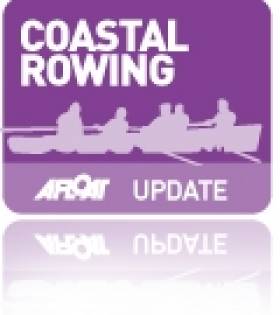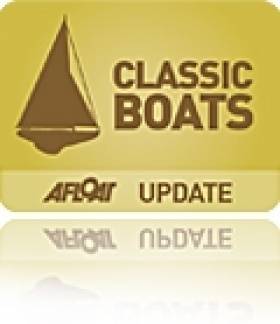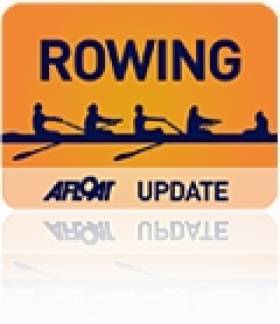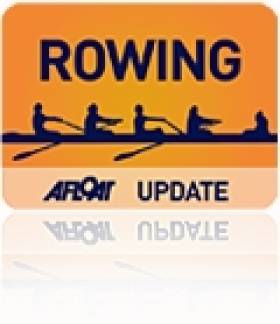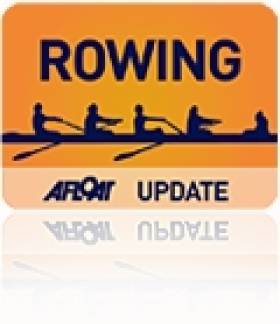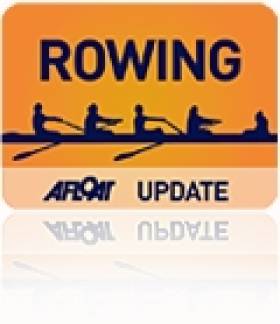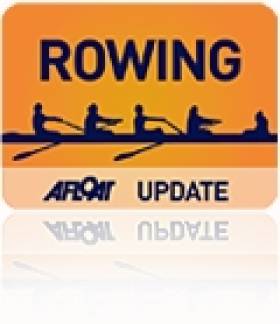Displaying items by tag: rowing
Last of National Rowing Heads takes place in Belfast Today
There are 148 crews over the three races starting with pairs and sculls, then doubles and fours and finishing in the afternoon with eights and quads. The third race features 35 eights and 26 quads.
The big race of the day, the men's senior eights, which starts at 3.45 pm, will feature a high intensity race between the two Queen's University eights. The A Queen's crew, with new strokeman, Mike Ewing, have been relatively the same crew for the last three years. This is the crew which mounted serious challenges to the victorious NUIG team at the Irish Rowing Championships, narrowly missing out on a national senior eight by a mere few feet on two occasions. The A team's Ewing won a Wyfold cup (men's coxless four) at Henley last year.
The women's intermediate eights should prove interesting with a crew entered from St Andrews in Scotland who will be up against Queen's University Ladies and St Michael's, Limerick.
The men's junior 16 eights sees all the Ulster crews up against each other whilst the men's junior 18 quads sees Blackrock College, Dublin, Shandon ,Limerick and Offaly Rowing Club take on the Ulster schools.
Eight crews will contest the men's Master's pennant (over 28s) with Galway, Bann and Athlone pushing the Belfast-based masters crews, Belfast Boat Club, Belfast Rowing Club and the Lady Victoria Boat Club, all the way. The former Queen's ladies rower ,Frenchwoman Solange Garrais is bringing a men's Masters and a women's Masters quad from Aviron Grenoblois, France to compete.
The 10.45 am and 13.15 pm races start at the Albert Bridge in Belfast and finish at Queen's boathouse at Stranmillis. The 15.45 pm race starts at the Odyssey building in Belfast Harbour and finishes at Queen's boathouse at Stranmillis. There are viewing points along the full length of each race.
The official start to the regatta season takes place on Saturday 2nd April with the Neptune regatta at Islandbridge, Dublin.
Click this link for Irish Rowing detailsClick this link for the Latest Rowing News
Irishman to Row Indian Ocean Naked
The Daily Edge reports on an Irishman who has announced plans to be the youngest man to row across the Indian Ocean - naked.
Keith Whelan, 30, intends to row the 6,000km route from Australia to Mauritius completely naked in an effort to raise money for anti-Aids charity Keep A Child Alive.
The event management consultant is taking the task completely seriously, having already trained for 18 months in preparation for the arduous task.
Whelan will be rowing in a 23-foot boat fitted with a radio, GPS, a satellite phone and computer equipment that will let him blog and tweet from the middle of the ocean.
If he completes the journey, Whelan would be the first Irishman to complete the Indian Ocean route solo - let alone in the nude.
The Daily Edge has more on the story HERE.
Queen's and Portora Impress at Erne Head
Two men’s senior eights from Queen's University slotted into the first two slots at the Erne Rowing Head of the River at Enniskillen. The junior 18 quadruple of the host club, Portora, had a fine result, finishing joint eighth overall.
Erne Head of the River, Enniskillen
Overall: 1 Queen’s A men’s senior eight 19 minutes 53 seconds, 2 Queen’s B men’s senior eight 20:21, 3 University of Limerick/St Michael’s men’s senior eight 20:40, 4 Trinity men’s intermediate eight 20:59, 5 Bann men’s junior 18 eight 21:09, 6 Methodist College, Belfast men’s junior 18 eight 21:47.
Men, Eight – Senior: 1 Queen’s A 19:53, 2 Queen’s B 20:21, 3 University of Limerick/St Michael’s 20:40. Intermediate: Trinity 20:59. Novice: 1 Trinity 21:47, 2 Queen’s 22:38, 3 Queen’s B 24:51. Junior 18: 1 Bann 21:09, 2 Methody 21:47, 3 St Joseph’s 22:02. Junior 16: St Joseph’s 23:50. Masters: Belfast BC (E) 24:06.
Four/Quadruple Sculls – Senior: 1 Belfast RC (quadruple) 23:01, 2 LSC (quad) 24:45. Intermediate: 1 Trinity (quad) 22:17, 2 Queen’s (coxed four) 23:39, 3 University of Limerick (quad) 23:59. Junior 18: 1 Portora (quadruple) 22:02, 2 Commercial (quad) 22:51, 3 Portora (coxed four) 22:56. Junior 16: Bann (quad, coxed) 24:05.
Women, Eight – Senior: 1 Trinity 23:42, 2 NUIG 23:51. Intermediate: 1 Queen’s 23:45, 2 Trinity 26:02, 3 Methody 26:16. Novice: 1 Queen’s 25:07, 2 Trinity A 26:29, 3 Trinity B 26:40. Junior 18: 1 St Michael’s 24:41, 2 Portora A 27:24. Masters: Belfast BC (D) 25:39
Four/Quadruple – Senior: 1 Portora (quadruple) 24:32, 2 Trinity (coxed four) 27:28, 3 Garda 28:11.
Click this link for Irish Rowing detailsClick this link for the Latest Rowing News
Unique footage of 1926 Dun Laoghaire Regatta Uncovered
Here's a unique glimpse of a post World War One Dun Laoghaire Regatta in rare newsreel recently archived by British Pathe (below). The shots taken on August 2nd 1926 show a mixture of long shots of yachts sailing across Dublin bay. There's definitely lovely shots of Dublin Bay 21s enjoying a tight race, a brave gybe by a Dublin Bay 25 at the harbour mouth plus shots of some Howth 17s.
There's panning shots of in harbour rowing races and high angled shots of men diving off the side of a boat and into the harbour. The swimmers race the length of an area cordoned off by rowing boats with spectators watching from the boats. There is also a shot of women's swimming race and some diving too.
We'd like your observations on these shots, particularly any details of the large committee boat dresssed overall. Leave your comments below. Enjoy.
Scroll down for the clip.
UCD Rule the Waves at Dublin Head
UCD’s men’s senior eight was the fastest rowing crew of the 35 which competed at the Dublin Head of the River. The conditions were surprisingly choppy, even in relatively light winds. The Dublin college also won the novice eights pennant, with Queen’s University second, and the women’s senior eight, with Trinity over five seconds back.
Dublin Head of the River
Overall: 1 UCD men’s senior eight 12 minutes 16.46 seconds, 2 Neptune men’s senior eight 12:49.06, 3 UCD men’s intermediate eight 15:52.20.
Men, Eight – Senior: 1 UCD 12:16.46, 2 Neptune 12:49.06. Intermediate: 1 UCD 12:57.20, 2 Commercial 13:43.07. Novice: 1 UCD 13:31.29, 2 Queen’s 13:43.77, 3 Trinity 14:00.02. Junior: 1 Colaiste Iognaid 13:44.93, 2 Cork 13:55.0, 3 Neptune 14:15.82. Masters: 1 Commercial 13:31.09, 2 Old Collegians/Three Castles 15:14.04, 3 Castleconnell 16:43.96.
Four – Senior: Commercial 14:01.36.
Women, Eight – Senior: 1 UCD 14:46.18, 2 Trinity 14:51.85. Intermediate: Commercial 15:45.32. Novice/Junior: 1 Cork (junior) 15:22.00, 2 Neptune (junior) 15:45.69, 3 UCD 15:57.66. Masters: Commercial 18:12.15.
Click this link for Irish Rowing detailsClick this link for the Latest Rowing News
NUIG and Grainne Mhaol to Fore at Carrick
NUIG and Grainne Mhaol took the National rowing Head senior fours crown at the Carrick-on-Shannon head of the river. The senior doubles title went to the UCC/Galway Rowing Club combination of John Wholley and Danny O’Dowd.
Carrick-on-Shannon Head of the River, Carrick-on Shannon, Saturday (Selected Results)
First Head: National Four-Blade Head – Men, Sculling, Double – Senior: 1 UCC/Galway 21:38.3, 2 Carlow 22:58.3, 3 Galway 23:13.7. Intermediate: 1 Three Castles 22:19.3, 2 Athlone 23:13.7, 3 Garda 26:26.3. Junior 18: 1 Portora 22:06.6, 2 St Joseph’s 22:11.9, 3 Carrick-on-Shannon 23:16.6. Junior 16: Commercial 24:35.5. Masters: City of Derry 25:02.9 (adjusted).
Women, Four – Senior: NUIG 25:23.9. Novice, coxed: NUIG 25:56.8. Junior 18: Galway 29:43.2. Junior 16, coxed: Commercial 26:11.6.
Other Results
Men, Eight – Senior: Grainne Mhaol/NUIG 19:29.1. Novice: UCD 23:25.6. Junior 18: Bann 20:14.8. Masters: Athlone 20:45.8. Junior 16: St Joseph’s 21:43.7. Masters: Athlone 20:45.8 (adjusted). Four – Senior: NUIG 22:19.2.
Sculling, Quadruple – Novice: Garda 22:29.6.
Women, Pair – Senior: NUIG 27:46.3.
Sculling, Quadruple – Senior: Belfast/Methodist/Queen’s 23:28.0. Novice, coxed: Commercial 29:58.0. Junior 18: Portora 21:51.1. Junior 16, coxed: Portora 26:20.3.
Single – Intermediate: Bann (Taggart) 27:11.4. Junior 18: Bann (Allen) 27:21.5. Junior 16: Methodist (Jacques) 26:36.9. Masters: Belfast BC (Lockwood) 29:00.7 (adjusted).
Head Two: National Four-Blade Head - Men, Four – Senior: 1 Grainne Mhaol/NUIG 19:59.5, 2 St Michael’s 21:40.6, 3 Galway 22:28.4. Intermediate, coxed: Bann 20:50. Novice, coxed: 1 Commercial 22:49.3, 2 Neptune 23:15.1, 3 Garda 23:32.0. Junior 18, coxed: 1 St Joseph’s A 21:03.5, 2 Portora 21:23.6, 3 Methodist, Belfast 22:14.6. Masters, coxed: Commercial 21:47.2 (adjusted).
Women, Double – Intermediate: Commercial 24:54.4. Novice: Commercial 31:29.6. Junior 18: 1 Carrick-on-Shannon 26:30.2, 2 Commercial 29:16.8, 3 Carlow 30:23.3. Junior 16: Galway 27:10.2. Masters: Lagan Scullers 31:17.4 (adjusted).
Other Results: Men, Eight – Intermediate: NUIG 19:32. Novice: NUIG 23:30. Junior 16: St Joseph’s 24:15.3
Pair – Junior 18: Methodist A 26:25.6
Sculling, Quadruple – Senior: Neptune 20:54.0. Junior 18: 1 Portora 20:02.6, 2 Carrick-on-Shannon 21:38.7, 3 Bann 21:41.5. Junior 16, coxed: Bann 22:07.1. Double - Intermediate: Garda 24:04.6. Single – Senior: Carlow (Coughlan) 25:10.7. Intermediate: Three Castles (Murphy) 24:12.5. Junior 18: Offaly (Gannon) 27:38.5. Masters: Belfast BC (Lockwood) 24:56.4 (adjusted)
Women, Eight – Senior: Methodist/Portora 22:31.2. Intermediate: NUIG 22:47.7. Novice: Carrick-on-Shannon 24:03.3. Junior 16: Portora 26:27.2.
Four – Novice, coxed: Garda 25:17.7.
Sculling, Quad – Novice, coxed: Offaly 30:46.6.
Click this link for Irish Rowing detailsClick this link for the Latest Rowing News
Cork Crews Rise to the Top at Cork Head
Cork crews saw off rivals from far and near at the Cork rowing Head of the River at the Marina on Saturday. UCC’s men’s senior eight were the fastest men’s crew – by 1.3 seconds from De Maas of Rotterdam, a masters eight. The fastest women’s crew was Cork Boat Club’s junior 18 eight, adjudged just .8 of a second quicker than UCD’s women’s senior eight. The fastest men’s single sculler was John Keohane of Lee Valley and Karen Corcoran-O’Hare of Shandon was the fastest women’s single sculler.
Cork Head of the River, The Marina, Cork, Saturday
Overall: 1 UCC men’s senior eight 12 minutes 6.7 seconds, 2 De Maas, Rotterdam men’s masters eight 12:08.0, 3 UCC men’s novice eight 12:25.9, 4 UCD men’s novice eight 12:42.4, 5 Presentation College men’s junior eight 12:44.3, 6 Muckross intermediate eight 12:49.9.
Men, Eight – Senior: UCC 12:06.7. Intermediate: Muckross 12:49.9. Novice: UCC 12:25.9. Junior: Presentation 12:44.3. Junior 16: Cork 13:21.2. Masters: De Maas 12:08.0.
Fours – Senior: Cork/Garda 12:53.6. Intermediate: UCC 13:40.6. Novice: Cappoquin 13:43.9. Junior 18, coxed: Presentation 13:04.0
Pair – Junior 18: Presentation 14:58.7. Masters: De Maas 13:09.9. Coastal – Novice: Ahakista 17:28.7.
Sculling, Quadruple – Senior: Shannon 13:50.8. Novice: Shannon 15:07.4. Junior 18: Cork 13:05.3. Junior 16: Cork 13:15.2.
Double – Intermediate: Cork IT 13:41.6. Junior 18: Clonmel 13:53.9. Junior 16: St Michael’s 15:04.4. Coastal – Novice: Kilmacsimon 16:17.2.
Single – Senior: Lee Valley (J Keohane) 14:16.4. Intermediate: Lee (O’Connell) 14:53.4. Novice: Lee (O’Connell) 14:37.9. Junior 18: Workmen’s (Burns) 14:33.0. Junior 16: Shandon (Casey) 15:08.9. Masters: Skibbereen (Barry) 15:40.07. Coastal – Novice: Kilmacsimon 17:33.6
Women – Overall: 1 Cork junior eight 13:40.0, 2 UCD senior eight 13:40.8, 3 St Michael’s junior eight 13:54.1.
Eight – Senior: UCD 13:40.8. Novice: UCC 14:25.4. Junior 18: 1 Cork 13:40.0. Junior 16: Clonmel 16:21.0.
Four – Senior: Muckross 14:15.9. Intermediate: UCC 17:00.9. Novice: UCC 16:29.8. Masters: Skibbereen 22:34.9.
Pair – Junior 18: St Michael’s 15:00.2.
Sculling, Quadruple - Novice: Shannon 15:51.4. Junior 16: St Michael’s 15:16.5.
Double – Intermediate: UCC 16:15.1. Junior 18: Cork 14:43.9. Junior 16: Lee 15:42.3. Masters: Cork 15:38.3.
Single – Senior: Intermediate: Shandon (K Corcoran-O’Hare) 15:39.7. Junior 18: Lee (Kearney) 16:52.1. Junior 16: Lee (Hamel) 16:13.6. Masters: Cork (Crowley) 17:49.2.
Coastal: 1 Kilmacsimon men’s novice double scull 16:17.2, 2 Ahakista men’s novice quadruple coxed scull 17:28.7.
Click this link for Irish Rowing detailsClick this link for the Latest Rowing News
New Ocean Centre to Open in Galway
The centre will provide facilities for all the watersports organisations in the city and region and is located in the new Galway Harbour Enterprise Park adjacent to the new harbour slipway that was built specifically for the Volvo Ocean Race in 2009. The 25,000 sq ft premises is being provided by Cold Chon (Galway) Ltd for a nominal rent and the land is being provided free by Galway Harbour Company.
Some of the clubs that have already committed to this new facility include the Galway Sea Scouts, Galway Sea Sports Association, Galway Sub Aqua Club, Bádoiri an Cladaigh, OYTI, Galway Coastal Rowing, Kayak Mor and Galway Bay Sailing Club.
'The Harbour Company is pleased to assist in pulling together the various water sport bodies under one roof and in the heart of the harbour. The new facility and the recently constructed slipway will be the focal point for Galway's marine leisure, getting Galwegians afloat and established in the city, commented Harbour Master', Captain Brian Sheridan.
The Centre is also hosting Let's Do It Global which ran the very successful Green Dragon campaign and the Galway Volvo Ocean Race Festival. The team is now working towards hosting a spectacular finish to the Volvo Ocean Race 2011-12 in July 2012.
The centre will provide operational facilities such as offices, changing rooms and storage facilities. There will be no social amenities or bars at the centre however it is anticipated that the establishment of the centre will provide impetus for attracting further watersport events to Galway.
The launch will take place at The Galway Ocean Sports Centre, Galway Harbour Enterprise Park, Galway City.
McCrohan and Maher Fastest in Newry Test
Lightweight scullers Michael Maher and Siobhan McCrohan were the fastest man and woman at the five-kilometre time trial at the Rowing Ireland National Assessment in Newry today. McCrohan won her battle with fellow lightweight Claire Lambe, and her time of 21 minutes 19 seconds was also two seconds faster than heavyweight Sanita Puspure. Lambe, who is 20, is an under-23 athlete and came out on top overall when her performance was ranked on percentage of projected gold medal winning time in her discipline.
Rowing Ireland National Assessments, Newry (Selected Results)
(Percentage is ranking with reference to projected World Championships gold medal winning time)
Men – Heavyweight: Under-23: E Mullarkey 20:38 (81.0).
Lightweight: 1 M Maher 19:46 (84.3), 2 M O’Donovan 19:51 (84.0), 3 A English 20:00 (83.3), 3 C Moynihan 20:18 (82.18), 4 J Brinn 20:34 (81.1). Under-23: 1 N Kenny 19:52 (86.0), 2 J Ryan 19:56, 3 S O’Driscoll 19:57 (85.6), 4 S Prendeville 20:02 (85.2), 5 J Mitchell 20:03 (85.2), 6 S Egan 21:28 (79.6).
Junior: 1 P O’Donovan 20:01 (86.2 per cent), 2 A Sheehan 20:32 (84.0), 3 N Prendiville 20:35 (83.8), 4 D Quigley 20:37 (83.7), 5 C Egan 20:38 (83.6), 6 L Seaman 2o:42 (83.3).
Women
Heavyweight: 1 S Puspure 21:21 (83.0), 2 E Moran 21:46 (81.4). Under-23: 1 L Dilleen 21:34 (84.1), 2 M Dukarska 22:09 (81.8), 3 S Bennett 22:49 (79.4).
Lightweight: 1 S McCrohan 21:19 (86.0), 2 O Hayes 21:53 (83.8). Under-23: 1 C Lambe 21:36 (87.0), 2 D Walsh 22:15 (84.4), 3 S Dolan 22:32 (83.4), 4 G Hosford 22:38 (83.0).
Junior: 1 S Dineen 22:05 (85.7), 2 K Cromie 22:55 (82.5), 3 K O’Brien 23:00 (82.2), 4 B Jacques 23:01 (82.2), 5 L Connolly 23:20 (81.1), 6 S Allen 23:28 (80.6). Under-23: 1 C Lambe 21:36 (87.0), 2 D Walsh 22:15 (84.4), 3 S Dolan 22:32 (83.4), 4 G Hosford 22:38 (83.0).
Click this link for Irish Rowing detailsClick this link for the Latest Rowing News
Elite Rowers Set High Standard in Newry
A number of Ireland’s elite rowers set personal bests during the ergometer (rowing machine) tests yesterday, the first day of the two-day National Assessments in Newry.
Top heavyweight oarswoman Sanita Puspure knocked three seconds off the time she set in December’s National Indoor Championships, while under-23 athlete Lisa Dilleen and lightweights Michael Maher and Claire Lambe also impressed. Rising star Sean Prendeville matched 22-year-old Maher’s time of six minutes 17 seconds for the 2,000 metre test, and outstanding junior oarsman Adrian Sheehan clocked 6:28. In the women's junior 16 category, Bridget Jacques again shone, with a time of seven minutes 23 seconds.
The men’s heavyweight class was hit hard by the absence of Colin Williamson (ill) and Sean Jacob (family bereavement).
National Assessment, Newry (Selected Results)
Men, Open: S Penny 6:13.0, D Neale 6:30. Under-23: E Mullarkey 6:14.0, M O’Brien 6:21.0, S Breheny 6:24. Under-20: C Logan 6:34.0.
Lightweight: M Maher 6:17, M O’Donovan 6:25, C Moynihan 6:26, A English 6:27. Under-23: S Prendeville 6:17, J Ryan 6:17.0, N Kenny 6:22.0. Under 20: S O’Driscoll 6:27.
Junior 18: A Sheehan 6:28, H Millar 6:29.0. Junior 16: A McGrath 6:45, C O Riada 6:45, P Hegarty 6:45.
Women, Open: S Puspure 6:46.0, E Moran 6:54.0. Under-23: L Dilleen 6:53.0, M Dukarska 6:59.0; Under 2o: S Bennett 7:12, C Fitzgerald 7:50.0
Lightweight: S McCrohan 7:20, O Hayes 7:27.0. Under-23: C Lambe 7:12.0, S Dolan 7:41.0, G Hosford 7:46.0, C Hurst 7:50. Under 20: D Walsh 7:34.0, L Shirlow 7:51.0.
Junior 18: K O’Brien 7:07, A Sheehan 7:13.0, R Shorten 7:20. Junior 16: B Jacques 7:23.0.
Click this link for Irish Rowing detailsClick this link for the Latest Rowing News



























